Created almost a thousand years ago Checkers is one of the most popular board games of all time. The reason the game has remained relevant for so long is that the game is so easy to play and yet still has a decent amount of strategy for experts. Checkers is so popular that it is one of the first games taught to most children. For me Checkers has always been one of those games that I really liked as a kid but I have always had some problems with it as it just feels like it is missing something. This has lead me to try and find a good variant for the game since I like the simplicity behind Checkers but I have been looking for something more. So far on Geeky Hobbies we have looked at Checkers4, Down the Tubes, King o’ Kings and King’s Court. While some of these games had some interesting mechanics, none of them were what I was looking for in a Checkers variant. I was hoping today’s game Skippity would be that game as it was designed by Susan MicKinley Ross best known for the board game Qwirkle. While Skippity is not a perfect game it is the best Checkers variant that I have ever played.
How to Play Skippity
Setup
Mix up all of the skippers/checkers. Randomly place one skipper on each space of the gameboard. The four skippers placed on the four middle spaces are removed from the board and are not used in the game. The oldest player will play first.
Playing the Game
On a player’s turn they will move one of the skippers on the gameboard. To move a skipper it has to jump over another skipper and land on an empty space. Skippers can only jump over another skipper vertically or horizontally (not diagonally).
A player is allowed to chain multiple jumps together using the same skipper. When jumping over multiple skippers a player can change directions as many times as they want. If a player sees a multiple jump opportunity they are not forced to make all of the jumps though.
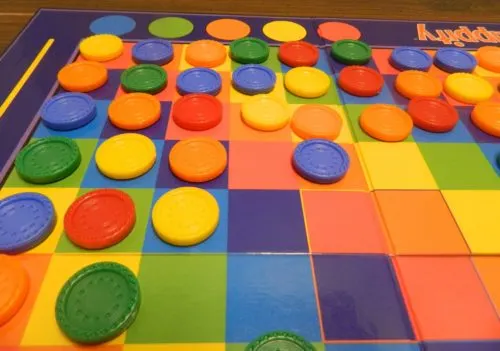
The yellow skipper on the left can jump over the orange skipper to the right and then jump over the blue skipper.
After a player has jumped over all of the skippers they pick up the skippers they jumped over. A player sorts the skippers they collect by color and place them on the corresponding spots on their side of the gameboard.
End of Game
The game ends when there are no more opportunities for a skipper to jump over another skipper. The skippers still on the board stay there.
Each player then counts up how many complete sets of skippers they have. A complete set of skippers is one skipper of all five colors.

This player has collected three red, three yellow, four orange, three green and five blue skippers. This player has scored three points.
If one player has collected more complete sets of skippers than the rest of the players they win the game. If two or more players have the same number of complete sets, the tied players count up their total number of skippers. The tied player with the most skippers will win the game. If there is still a tie, the remaining tied players share the victory.
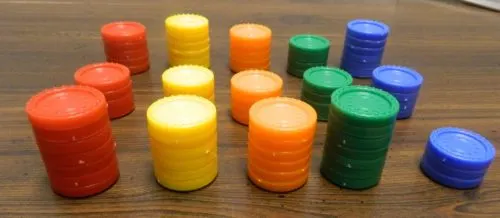
The front player has three complete sets so they have scored three points. The middle player has four complete sets so they have scored four points. The back player also has four complete sets so they scored four points. The back player will win the game though because they collected 26 skippers while the middle player only collected 20 skippers.
My Thoughts on Skippity
While we have not yet reviewed Qwirkle here on Geeky Hobbies it is a game that I really enjoy. For those of you not familiar with Qwirkle the easiest way to describe the game is that it kind of feels like simplified combination of Scrabble and a game like Dominoes. What I really like about Qwirkle is that Susan McKinley Ross did a fantastic job blending simplicity with strategy. Qwirkle is easy to play and yet has plenty of strategy for people that want it. When I saw Skippity I was curious about how Susan McKinley Ross would approach the game of Checkers.
Just like with Qwirkle, Skippity takes Checkers and slightly tweaks it to add some strategy while also keeping the game simple enough that anyone can play it. For anyone that has ever played Checkers (which should be most people) you should already be pretty familiar with how Skippity is played. The jumping mechanic in Skippity is basically exactly the same as Checkers except that you jump vertically/horizontally instead of diagonally. The one major difference in the gameplay is the fact that instead of controlling a color and trying to eliminate the other color, you aren’t in control of any particular color. Instead of trying to eliminate a color you are trying to collect skippers of all of the different colors. This leads to the most unique mechanic in Skippity which is the scoring system.
Most people would assume that the goal of Skippity would be to collect as many skippers as possible. If the scoring system emphasized quantity of skippers every player’s strategy would be to jump as many skippers as they could on any given turn. I think this would have led to a decent game but I think it would have gotten boring after a while. Focusing just on quantity would have added quite a bit of luck to the game as your success in the game would have relied on what the previous player left you. While it is not a good long term strategy, in the early game it makes a lot of sense to take as many skippers as you can on your turn as long as it doesn’t set up the next player to take even more skippers.
What makes Skippity really stand out is the fact that the quantity of skippers you collect is not as important as the color of skippers you collect. At the end of the game it doesn’t matter if you have collected a lot more skippers than the other players if you only focused on a couple colors. The only way to score points in Skippity is to collect a set of all of the different colors. While this is a pretty simple rule that has been used in other games, it is the mechanic that truly makes Skippity.
The reason this tweak to the scoring is so important is that it influences your decision on what pieces to jump throughout the game. While it might be best to just jump as many pieces as possible early in the game, you need to abandon that strategy in the mid to late game. Unless everything lines up perfect for you, there will be times where you will have to choose an option that will get you less skippers in exchange of getting skippers you really need. If the goal was just to collect the most skippers, the obvious decision each turn would be to make the move that gave you the most skippers without setting up the next player to get even more skippers. Being forced to collect the different colors though forces players to put a lot more thought into their decisions.
This decision on what colors to collect is responsible for most of the strategy in Skippity. Skippity is not a highly strategic game but it does a good job adapting to its’ audience. If you are playing the game with children or people that don’t play many board games you can play the game with each player quickly making a move and just seeing who ultimately wins the game. If you are playing the game with more strategic players though you can put a decent amount of thought into each move to determine what is the best option for you.
Just like Qwirkle Skippity really succeeds at being accessible to everyone and yet having enough strategy to keep more strategic players interested. I think you could literally teach the game to new players in just a couple minutes and they will be able to jump right into the game. While players who are more familiar with the game probably have a better chance of winning, Skippity is a game that is simple enough that everyone stays in the running until the very end of the game. When you add in that most games can be played within 20-30 minutes I could see Skippity working well with both children and adults.
So I enjoyed my time with Skippity and I think it will appeal to quite a few people. With that said I don’t think the game is perfect. I think the biggest problem with the game is that it shares so much in common with Checkers. While Checkers is a decent game, it gets kind of boring after a while. Outside of the scoring system Skippity plays quite a bit like Checkers. I can definitely see coming back to Skippity every so often but I don’t see it as a game that I could play for hours at a time. While I liked Skippity I don’t think it does enough that will make someone who doesn’t care for Checkers finally start liking it. If you have never really cared for Checkers’ jumping mechanic I just don’t see you really liking Skippity either.
The second issue I had with Skippity could also be seen as a positive. Based on my experience Skippity has an issue with ties. Some people might see this as a positive since all of the players tend to be very close to one another at the end of the game. I see most games truly coming down to the last couple of moves. I like that the game keeps all of the players in the game until the very end since it keeps the game interesting for everyone. The problem is that this tends to lead to a lot of ties. Let me give you an example. In one four player game two players ended up tied with the same number of sets and total skippers. The player in third place had the same number of sets but had one less total skipper. The player in last I think had the same number of skippers as everyone else but had one less set. In this game if only a couple things changed all four players could have easily been tied with no way of breaking the tie. I see a lot of games of Skippity ending in ties. While I don’t hate ties, I think it should be a rare occurrence rather than something that happens a lot.
The third issue I had with Skippity is that the game has a potential analysis paralysis problem. Now the analysis paralysis problem is not nearly as bad as a lot of other games but it can slow down the game. Early and late in the game players don’t have a lot of choices for their turn so the issue isn’t that bad. During the middle portion of the game though the number of options that a player has open to them expands quickly. While it is usually pretty easy to zone in on the area that is likely going to give you the best move, there are times when players might have to analyze the entire board to find the best move. For players that always need to find the optimal move this is going to add time to the game.
One thing that really adds to the analysis paralysis issue is the fact that you really can’t figure out your move ahead of time. If you are playing with four players there really is no reason to consider your potential options until the player before you takes their turn. I really don’t see the point in thinking of moves earlier since the board is constantly changing so it is unlikely that the board will look anything like what it did a couple turns earlier. With you basically having to wait for your turn to analyze your options this does lead to a decent amount of analysis paralysis. This never gets too bad but I wish there was a way that players could actually think about their move ahead of time since that could reduce the waiting time quite a bit.
I really wouldn’t consider this to be a complaint but the component quality of Skippity is pretty average overall. There is nothing terribly wrong with the component quality of Skippity but it is nowhere near the quality of Qwirkle. Basically the game comes with a cardboard gameboard and 100 checkers of five different colors. While I appreciate the number of checkers I can’t really say that there is anything special about them. They are very basic plastic checkers. There is also nothing really wrong with the gameboard as it is mostly just a board featuring squares of various different colors.
Should You Buy Skippity?
Overall I would say that Skippity is on the edge between being a good and a great game. The game has a lot going for it. It is the perfect balance of being accessible while still having strategy. The game is pretty quick and is simple enough that anyone should be able to play it. Skippity takes the basic premise of Checkers and adds a couple small tweaks that significantly improve upon the Checkers formula. I would say that Skippity is the best Checkers variant that I have played. Skippity is still a Checkers variant though so I don’t see it appealing to people that don’t care for Checkers. The game also has a potential tie problem and there is a possibility for some analysis paralysis.
If you have never really cared for Checkers or mostly only care about heavier strategy games I don’t think Skippity is going to be for you. If you like accessible games though and have always wanted a good Checkers variant, I think Skippity might be the game you are looking for. If Skippity sounds like the type of game that you would enjoy I would recommend picking it up.
If you would like to purchase Skippity you can find it online: Amazon, eBay

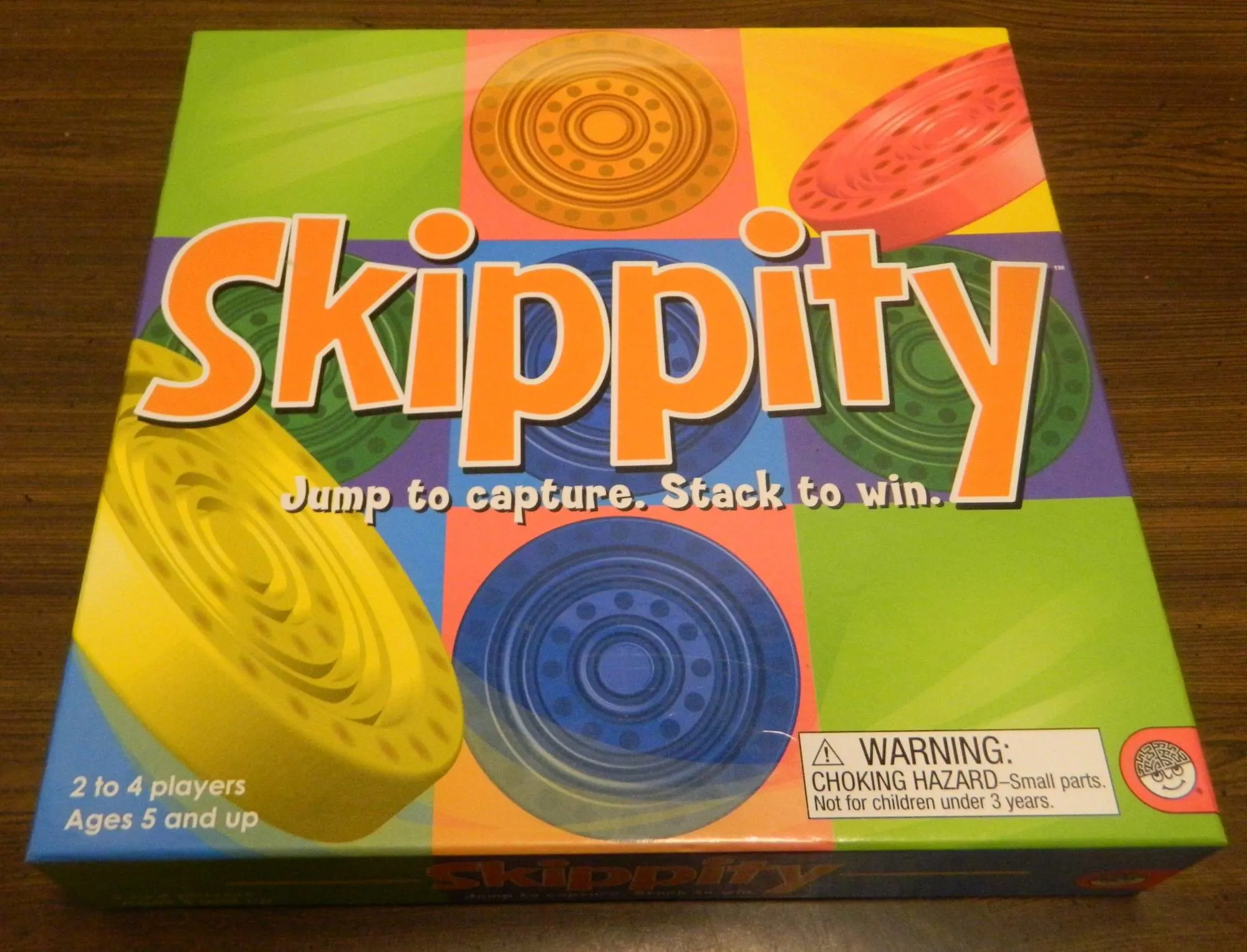
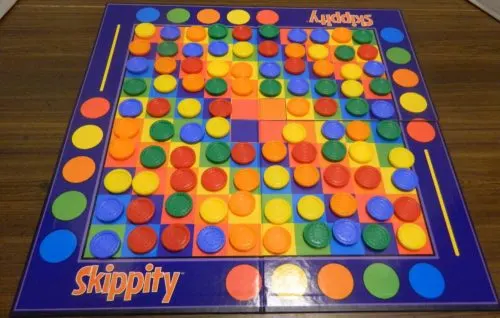
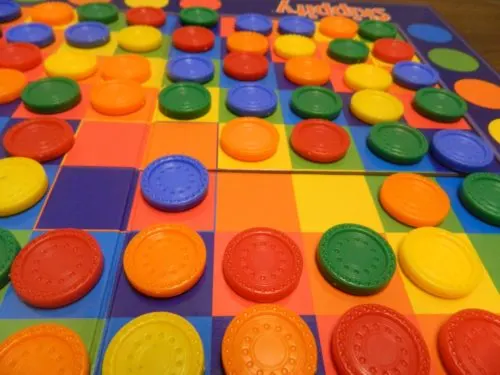
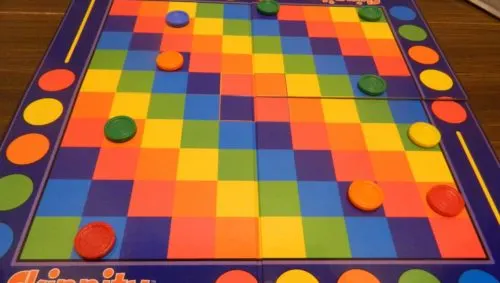
Gerald altus
Sunday 25th of February 2018
Skippity
When does the 2n of 4 goes after the oldest Starts.
Eric Mortensen
Sunday 25th of February 2018
My copy of Skippity is currently in storage and is too hard to find at this point. I am not exactly sure what you are asking in your comment. Based on my recollection of playing the game I believe after the oldest player plays, the player to their left (clockwise) then takes the next turn. There is a slim chance that the next player is to the player to the right (counterclockwise) though.